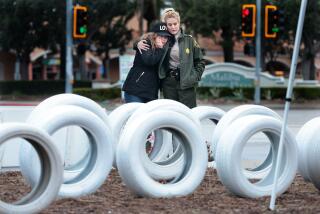To Find Motorists Driving Under the Influence : Paramount Wants Drug Checkpoints Set Up
PARAMOUNT — In a continuing fight to rid the community of drug trafficking, city officials want to set up checkpoints to find motorists driving under the influence of narcotics.
The checkpoints would be similar to sobriety stations used by various police agencies looking for drunk drivers.
Officials have asked the Los Angeles County Sheriff’s Department, which provides law enforcement service to the city, to set up the checkpoints.
“The goal is to let people know that this is not the place to do it (use drugs). We also hope to show residents this city is going to deal with the problem,” City Manager William A. Holt said.
Neighborhood Drug Problem
Holt said the checkpoints are part of the city’s effort to battle a drug problem in one of its neighborhoods. Last month, undercover sheriff’s deputies arrested 56 people on drug charges in the 15300 block of Gundry Avenue. The charges included possessing, selling and purchasing rock cocaine. The city closed of a portion of the street by building a concrete storm drain to create a cul-de-sac. Two deputies on bicycles now patrol the area.
City officials believe this is the first time a community has requested that a checkpoint be established to look specifically for people under the influence of a drugs.
The Sheriff’s Department is reviewing the city’s proposal, said Lt. Robert Mirabella of the Lakewood sheriff’s substation. Narcotics and traffic experts must determine whether there have been enough drug-related accidents to justify the roadblocks.
At sobriety checkpoints, deputies have cited drivers for driving under the influence of alcohol and drugs, but this may be the first time a checkpoint would be established primarily to check for drivers impaired by drugs, Mirabella said.
Jack R. Winkler, assistant attorney general, has informed city officials that the California Supreme Court ruled in a 1987 case that it would be legal to conduct police roadblocks as long as the purpose was to remove impaired motorists who endanger others. However, Winkler said the court held that these checkpoints could not be used as a means of stopping vehicles and searching for evidence.
“The primary objective of the sobriety checkpoint is to take drivers (who are under the influence) off the road. It can’t be used to search for evidence,” Winkler said.
Holt said the city would follow the guidelines established by the court, which include notifying the public about the checkpoints in advance and using a formula, such as stopping every fourth car.
“We always believe that the narcotics checkpoints modeled after the alcohol checkpoints were constitutional,” Holt said.
Paul Hoffman, legal director of the American Civil Liberties Union’s Southern California chapter, said the organization opposes checkpoints and does not believe the government should be able to stop people without a reasonable basis.
However, Hoffman added, “It is hard to criticize Paramount without knowing how it works. We’ll have to look into it to see that the program is monitored.”
Robert D. Robinson, city director of public safety, said the city hopes the checkpoints will be set up in two or three weeks. Holt also said it was uncertain how often the checks would be conducted.
Officials have not decided upon a location but it probably will be in an area near the Gundry Avenue, Robinson said.
Under the plan, deputies trained in the detection of both alcohol and narcotics will be at the checkpoints, Robinson said.
Narcotics experts would be looking for such signs as involuntary eye jerking, dilated or constricted pupils, confusion and slurring speech.
Ronald Bowers, assistant district attorney, said if officers determine by observation or a field sobriety test that a person is under the influence of some substance other than alcohol, a urine or blood test could be administered to detect the type of drugs.
More to Read
Sign up for Essential California
The most important California stories and recommendations in your inbox every morning.
You may occasionally receive promotional content from the Los Angeles Times.










